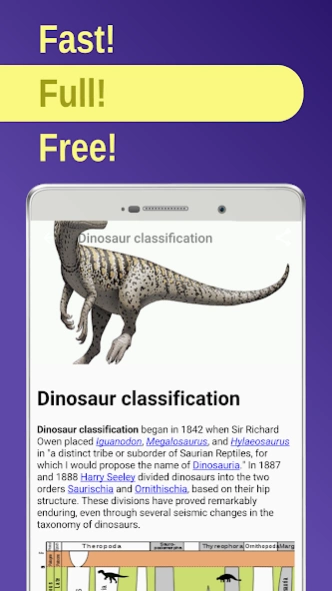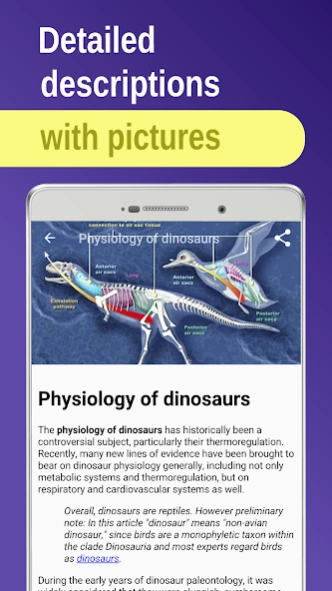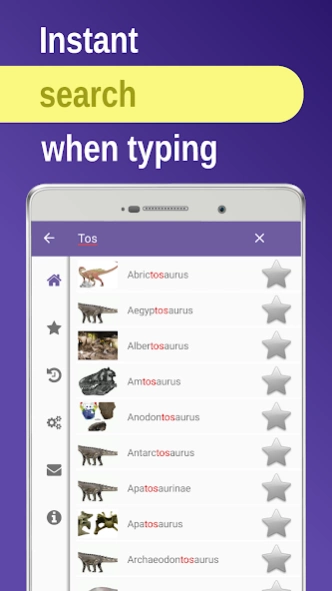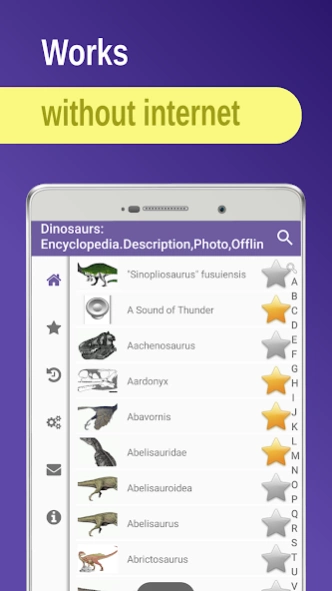Dinosaurs. Paleontology 3.8.5
Free Version
Publisher Description
Dinosaurs. Paleontology - Fossil remains. Clades. Taxonomy. Сlassification
Big scientific encyclopedia "Dinosaurs. Paleontology": fauna of geological periods, evolution, mass extinctions.
Paleontology is the science of life that existed before the beginning of the Holocene era or at its beginning (about 11,700 years ago), in past geological periods. It includes the study of fossils (fossil remains) to determine the evolution of organisms and their interactions with the environment (paleoecology).
Paleozoology is a branch of paleontology that studies fossil animals. They are conventionally divided into paleozoology of vertebrates and invertebrates. Paleozoology studies biological diversity, its change in time and space. This diversity is established through morphology, the determination of the systematic composition and the construction of new classifications.
The Permian period (Perm) is the last geological period of the Paleozoic era. It began about 299 million years ago and lasted for about 47 million years. It ended about 250 million years ago with the greatest mass Permian extinction in the history of the planet. Period deposits are underlain by Carboniferous and overlapped by Triassic ones.
Archosaurs (lat. Archosauria) are a clade of diapsid reptiles, represented at the present time by crocodiles and birds, and from extinct organisms also: non-avian dinosaurs, pterosaurs and others.
Avemetatarsalia (lat.Avemetatarsalia) is a clade of animals, the definition of which was first given in 1999. It is one of the two main branches of archosaurs, including the clade Dinosauromorpha and Pterosauromorpha, united under the common name Ornithodira, as well as the clade Aphanosauria. In general, the number of amemetatarsalia includes all archosaurs, which are closer to dinosaurs and modern birds than to crocodiles by seven synapomorphic features.
Megalosaurus (lat.Megalosaurus) is a genus of large carnivorous theropod dinosaurs from the Megalosauridae family, including the only valid species - Megalosaurus bucklandii. Megalosaurs reached 9 meters in length and were bipedal predators weighing about a ton. The structure of the cervical vertebrae suggests that the neck of these dinosaurs was quite flexible. The hind limbs had four fingers, three of which were directed forward (the megalosaurus rested on them when walking); one finger pointing backward was reduced. The forelegs are short.
Triceratops (lat.Triceratop) is a genus of herbivorous dinosaurs from the family of ceratopsids, existed at the end of the Maastrichtian Cretaceous period, from about 68 to 66 million years ago in the territories of modern North America. The appearance of the Triceratops is easily recognizable - a large bone collar, three horns on the muzzle, large thick limbs and a physique similar to a rhinoceros. Perhaps the most dangerous predator of the time, the Tyrannosaurus Rex, could have hunted Triceratops, but it is unclear if they could have fought each other, as is often depicted.
Iguanodon (lat.Iguanodon) is a genus of herbivorous ornithisch dinosaurs. It is believed that the only species whose belonging to the genus of iguanodons is beyond doubt is I. bernissartensis, which inhabited the territory of modern Belgium, Spain and some other countries approximately 126-125 million years ago (Early Cretaceous period). Distinctive features of the iguanodon were a sharp claw on the thumb, which was supposedly used for protection from predators, and tenacious fingers, adapted to search for food.
This dictionary is free offline:
• contains more than 4000 definitions of signs and terms;
• ideal for professionals, students and hobbyists;
• advanced search function with autocomplete - the search will start and predict a word as you enter text;
• voice search;
• work in offline mode - the database supplied with the application does not require data costs when searching;
• includes hundreds of examples to illustrate definitions.
About Dinosaurs. Paleontology
Dinosaurs. Paleontology is a free app for Android published in the Teaching & Training Tools list of apps, part of Education.
The company that develops Dinosaurs. Paleontology is 99 Dictionaries: The world of terms. The latest version released by its developer is 3.8.5.
To install Dinosaurs. Paleontology on your Android device, just click the green Continue To App button above to start the installation process. The app is listed on our website since 2024-01-19 and was downloaded 2 times. We have already checked if the download link is safe, however for your own protection we recommend that you scan the downloaded app with your antivirus. Your antivirus may detect the Dinosaurs. Paleontology as malware as malware if the download link to com.dictionary.dinosaurs.history.museum.dinosaursnames is broken.
How to install Dinosaurs. Paleontology on your Android device:
- Click on the Continue To App button on our website. This will redirect you to Google Play.
- Once the Dinosaurs. Paleontology is shown in the Google Play listing of your Android device, you can start its download and installation. Tap on the Install button located below the search bar and to the right of the app icon.
- A pop-up window with the permissions required by Dinosaurs. Paleontology will be shown. Click on Accept to continue the process.
- Dinosaurs. Paleontology will be downloaded onto your device, displaying a progress. Once the download completes, the installation will start and you'll get a notification after the installation is finished.



